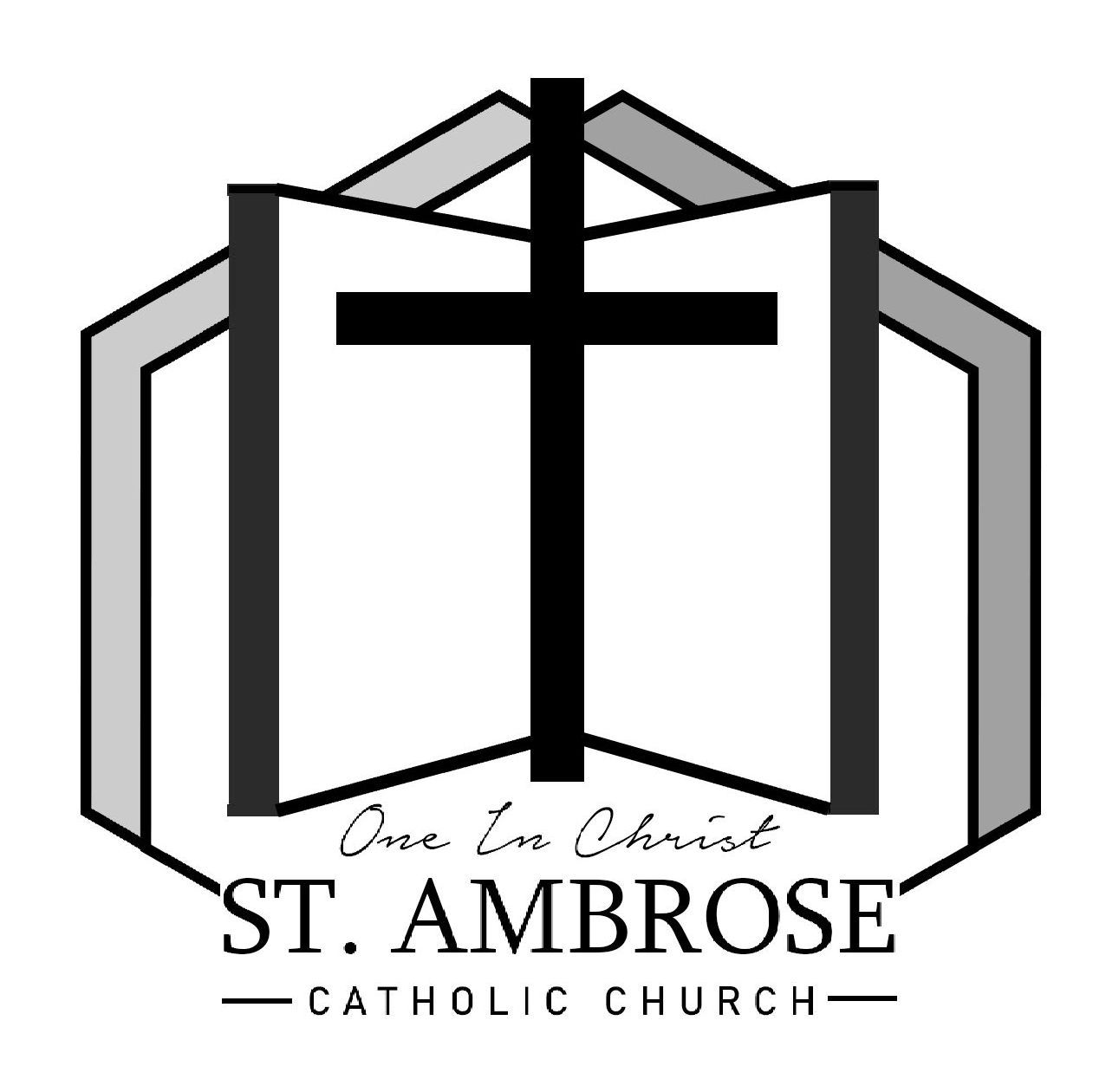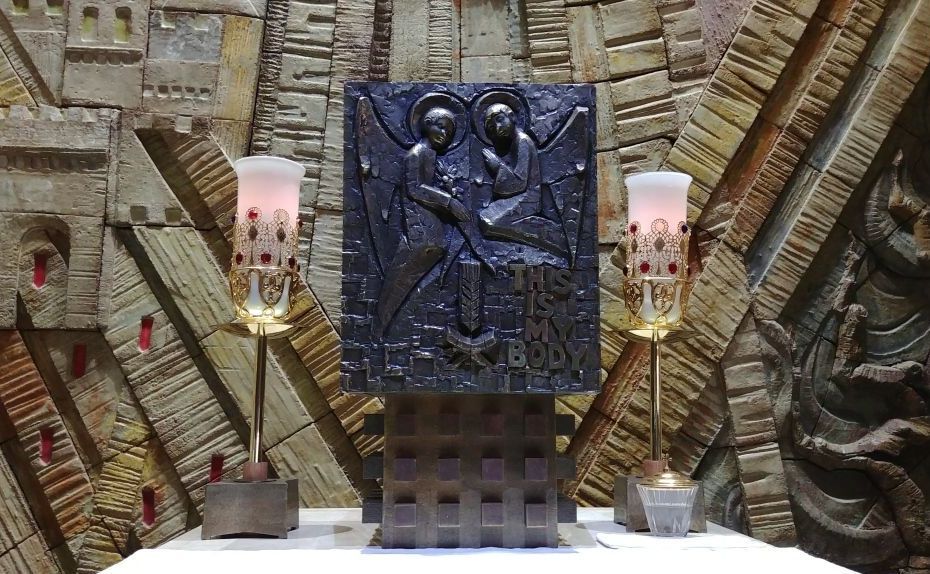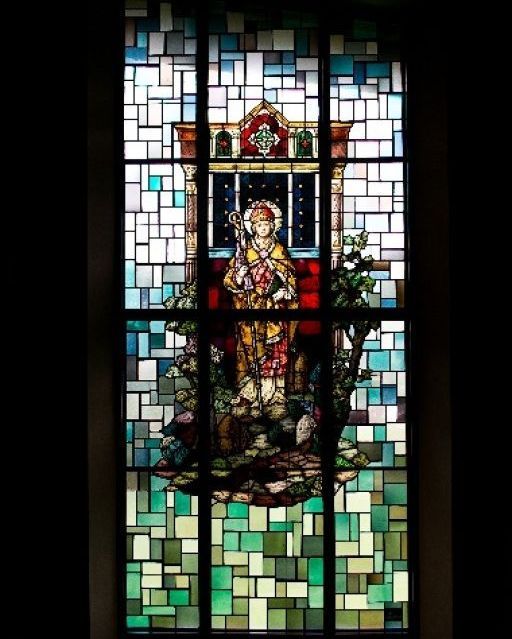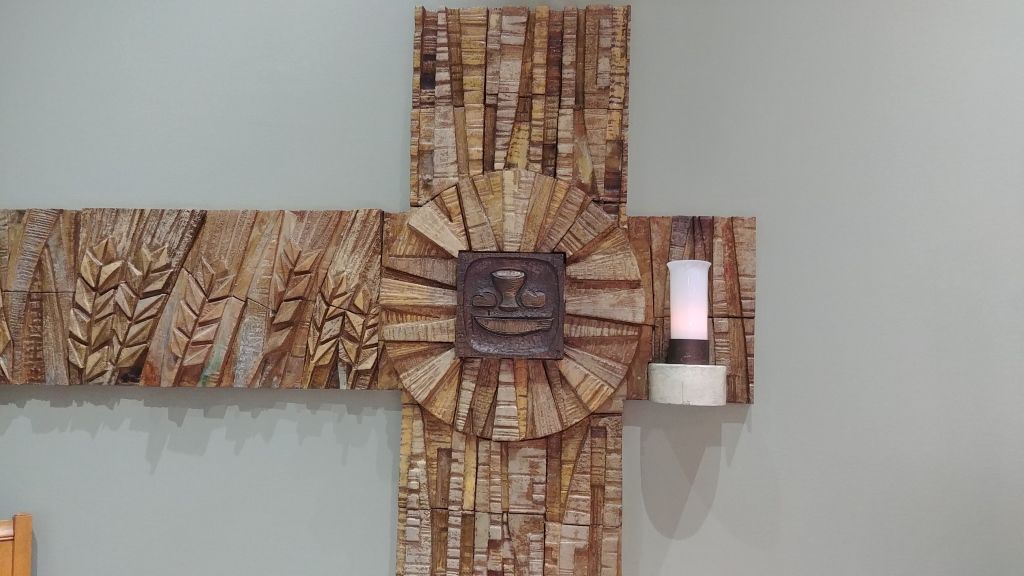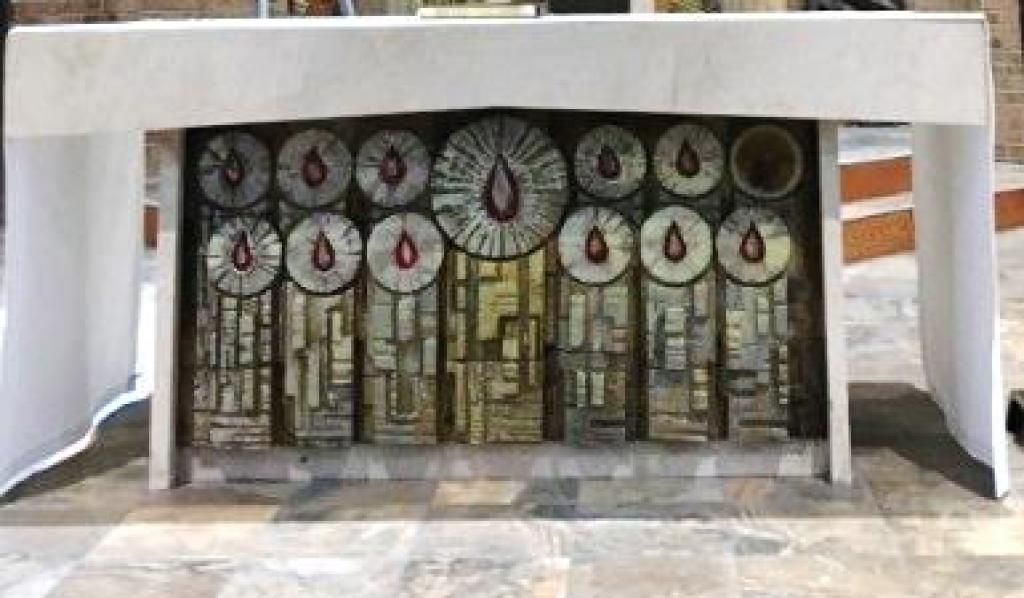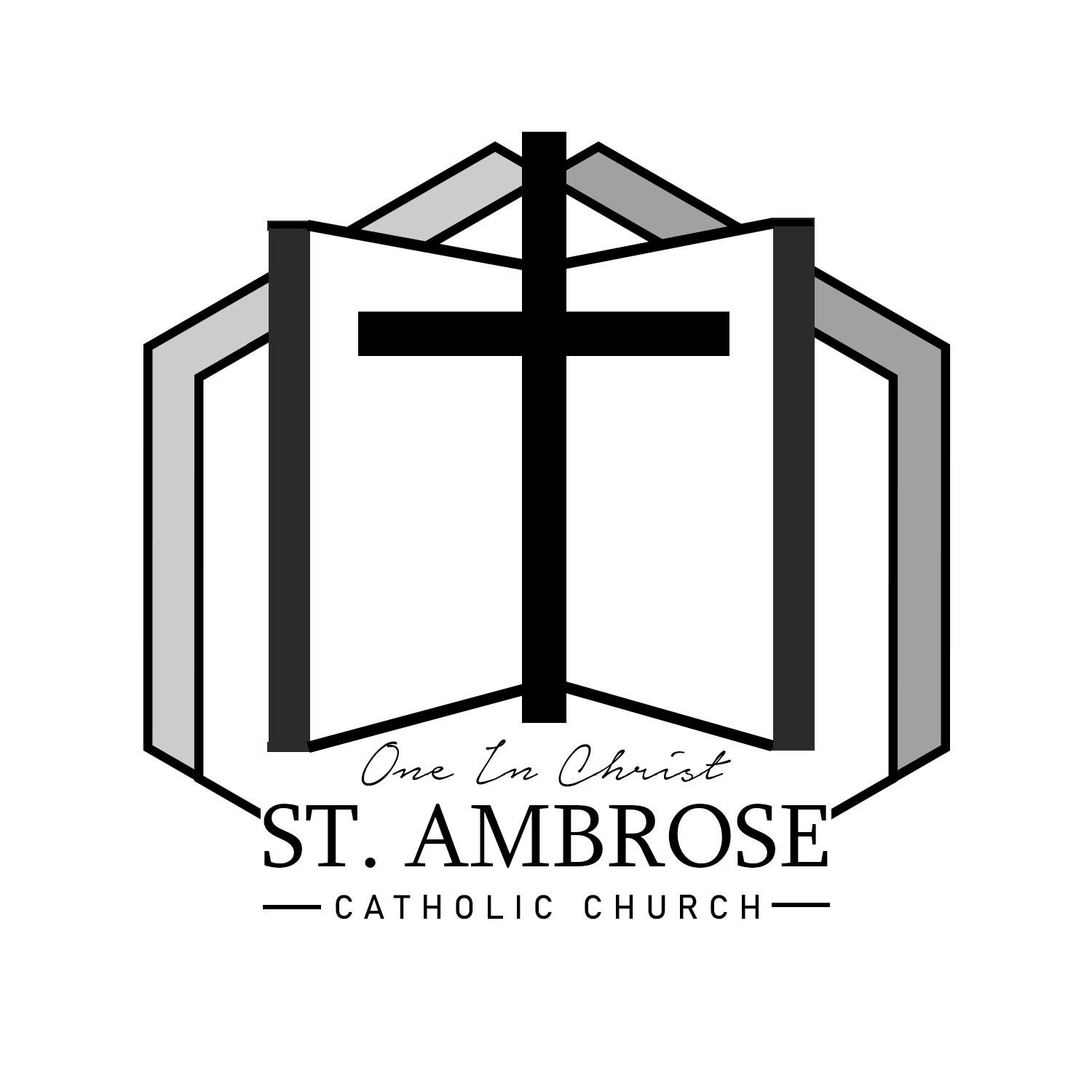Our Story
Welcome to St. Ambrose Parish
St. Paul tells us in Ephesians 2:19 that we are “members of the household of God”. Welcome to St. Ambrose Parish, a parish within the Diocese of Allentown. We would like to share with you information about our patron St. Ambrose, St. Ambrose Parish and St. Ambrose Church, our “house of God”. The information was presented in the book “St. Ambrose – New Church” which was published for the April 16, 1978 dedication of our present church.
St. Ambrose – Doctor of the Church
Saint Ambrose was born into an ancient noble Roman family and was well educated in law. He was appointed Governor of Liguria and Aemillia with residence in Milan, Italy. When the Bishop of Milan died in 374 A.D., Ambrose, as Governor, came to Milan to insure order and peace. He was so popular and loved by the people that he was unanimously chosen to be Bishop even though he was only a catechumen or beginner in the Faith. When he was 35 years old he was baptized, ordained a Priest, and consecrated Bishop of Milan on December 7, 374 A. D., his feast day in the Church. He immediately gave up all his worldly goods and gave his personal property to the poor. He became famous for his piety, spirituality and as an eloquent preacher of Catholic doctrine. He was Bishop of Milan from 374 to 397 A. D.
St. Ambrose received the title “Doctor or Teacher of the Church” because of his writings which include more than six large volumes covering almost all facets of Christian Dogma. He wrote a book titled “On Penance” in which he gave evidence of the power of the Church to forgive sins, the necessity of Confession and the meritorious power of good works. He was the originator of chant in the music of the Church and introduced the responsorial psalms between the readings. He wrote many hymns. Two of the most famous are “Veni, Creator Spiritus” or “Come, Holy Ghost” and the “Te Deum Laudamus”, We Praise Thee O God”.
St. Ambrose died on Good Friday in the year 397 A.D. One of his successors as Bishop of Milan was Pope Paul VI who was archbishop of Milan before being elected the Bishop of Rome and head of the Universal Church in 1963. Pope Paul VI implored the Apostolic Blessing on the occasion of the solemn Blessing of St. Ambrose church on April 16, 1978.
St. Ambrose Parish
The early history of our Parish began in 1847 when St. Ambrose Church was established as a mission of St. Patrick Church, Pottsville. Mass was celebrated in the home of Patrick White who lived in the Irish Flats section of Schuylkill Haven. Today this area is the site of Island Park. Eventually an abandoned school house was purchased in the eastern part of town to hold devotions. During this time, from 1854 to 1858, the then Bishop of Philadelphia, and now Saint John Neuman, the first American Bishop to become a saint, conferred the rite of confirmation in St. Patrick Church in Pottsville on confirmands from St. Ambrose Parish.
In 1863, St. Ambrose Parish bought a church located at Broadway and Dock Street in Schuylkill Haven. It was called St. Paul’s Church of Spring Garden and was built by a Union Congregation of Lutheran and Reformeds in 1851. Spring Garden was a separate village adjoining the village of Schuylkill Haven. St. Paul’s Church was sold for back taxes at a Sheriff’s sale to the Schuylkill Haven School Board. St. Ambrose Parish acquired the church from the School Board and suitably adapted it. As the parish grew, the rectory was built in 1898 and the convent was built in 1914. In 1914 a school was built behind these buildings. Today the former rectory and convent are private residences. The former church has been converted into student housing.
In 1955 St. Ambrose Parish purchased the Deer Lake Theater and converted it into St. Kunegunde Chapel to serve the parishioners of the southern end of the parish. Over time, the chapel was closed and sold. Today the site of where the chapel was located is along Route 61 in the area of the jug handle at the intersection of Routes 61 and 895 at Deer Lake.
St. Ambrose RC Church
Over the years our parish continued to grow. It became impractical to renovate the old church which was over 125 years old and obsolete for the needs of the parish. After Bishop McShea appointed Rev. Alfred Ott as administrator of St. Ambrose Parish in 1971, plans were laid to relocate the Parish buildings to more spacious surroundings. In 1972, the 14 acres of ground where our Parish campus is now located were purchased from a parishioner. The building of our church was accomplished because of the donations of the parish family at that time. Many parishioners memorialized the contents of our church from the Altars of Sacrifice in the Main Church and Chapel to the American flag to the Holy Water Fonts. Ground breaking for the “new” St. Ambrose Church was able to be held on Thanksgiving Day, November 26, 1976. Even though not all details were completed, the church was opened for the first Sunday Masses on March 4 and 5, 1978.
As parishioners approach our church they are greeted by four flags and the bell from the “old” St. Ambrose Church. The flagpole on the left displays the American flag and a flag to Support our Troops. The pole on the right displays the Papal flag and the flag of St. Ambrose.
The theological theme around which our church was built is “We must be LOOKING in our life each day for Christ’s second coming and LIVING our life each day so that we will be with Him when we are judged.” The central theological idea around which our church is built is CHRIST HAS DIED, CHRIST IS RISEN, CHRIST WILL COME AGAIN.
Once inside the church, from the lobby we see the etched wheat field, which symbolizes the bread, on the entrance doors to Our Lady of the Blessed Sacrament Daily Mass Chapel. Behind the altar, the ceramic cross done in wheat design symbolizes the shadow of the cross which reminds us that CHRIST HAS DIED. The beaten bronze grapes on the beautiful cream marble altar symbolize the wine. Two adoring angels in bronze are incorporated in the legs of the altar. The Holy Family is represented in the statues on either side of the sanctuary. The Christ the King crucifix next to the Blessed Mother statue is adorned with symbols of the four Evangelists. To the left of the Sanctuary is the Our Lady of the Blessed Sacrament window in which Mary is shown holding Jesus in her arms. He is holding the Host and Chalice, His Body and Blood. A majestic angel balances out the window. To the right of the Sanctuary is the Last Supper window which carries out the Eucharistic theme of the chapel. Below this window, amid the candles, is a beautiful cross which contains a first-class relic of St. Ambrose. On the back wall of the Chapel there are two hand-carved ¾ size wooden plaques. The one on the right is honoring “The Sacred Heart of Jesus” and the one on the left is honoring St. Ambrose. We see the honey comb cells around the head and miter of St. Ambrose because the beehive is the symbol of the sweetness of his preaching.
Across the lobby from the Daily Mass Chapel, which is dedicated to honor Mary, we see the entrance doors to the Main Church. The procession of etched figures represents the whole parish family coming together to worship. We are reminded of our Baptism when enter the church and stop at the Baptismal Font to bless ourselves with Holy Water. The blue panels in the base suggest the flowing waters of Baptism with the crosses showing salvation coming through Christ’s Death and Baptism. The tiled floor beneath the Font represents flowing water. The Holy Spirit is represented by the bronze dove suspended over the Font.
The dominant feature of the spacious Sanctuary is the Reredos, the three-dimensional ceramic mural of “The Christ of the Parousia” behind the altar, which completes the theological theme CHRIST WILL COME AGAIN. Holy Scripture tell us that Jesus will return at the end of time to judge all people. He will divide those being judged into two groups. The figure of Jesus shows that to those on the right (notice the open hand in welcome) He says “Enter, Blessed of My Father into the kingdom prepared for you from all eternity”. St. John speaks of the heavenly kingdom as the heavenly Jerusalem, so the artist of the Reredos portrays the heavenly city using the architecture of Jerusalem. Vertical red marks show the souls of the saved, washed in the Blood of Jesus the Lamb entering the Heavenly Kingdom. To those on the left (notice the hand turned away in rejection) Jesus says, “Depart from me, you accursed ones”. In this corner of the mural is the Tree of the Knowledge of Good and Evil from the Garden of Paradise where sin originated. The tree is shown without leaves or fruit, and is darkened, withered, gnarled and dead.
At the feet of Jesus is the bronze tabernacle where the Blessed Sacrament is reserved after Holy Communion is distributed. The tabernacle sits atop a cream marble base. Two adoring angels kneel on each side of the tabernacle. Christ’s Real Presence is shown on the tabernacle doors in the words which Jesus spoke at the Last Supper, “This is My Body.”
The Main Altar is made of ceramic mural and is topped with Spanish cream mirafil marble. Here the artist portrays the Last Supper, with Jesus as the center candle surrounded by the twelve apostles represented by the other candles. The one candle on the extreme right which sheds no light represents Judas who betrayed Jesus. This candle is placed on the side of rejection.
To the right of the altar is the hand carved life-sized Crucified Christ on the Cross. To the left of the altar are three hand carved figures which represent the Holy Family: Joseph, Jesus and Mary. On the marble pulpit beneath the Holy Family the symbols for the four Evangelists are etched into the marble of the pulpit.
The beautiful stained- glass windows provide a beautiful link between the future, present and the past. The six large windows were taken from the old church and redone by the Edward F. Byrne Studio of Doylestown. These windows were originally executed by the Adolph Meier Studio in Munich, Germany in the 1800s. Each window contains intricate beautiful details.
Facing the back of the church you see along the left wall in the place of honor, St. Ambrose. Next is Jesus appearing to St. Margaret Mary and revealing the devotion to the Sacred Heart. The third window shows Jesus giving the keys to the kingdom to St. Peter. Along the right wall is Jesus welcoming and blessing the little children. The next window is honoring Mary under the title of “The Immaculate Conception” by the Spanish artist Murillo. Our Lady is the Patroness of the United States. The third window shows the Holy Family in their home in Nazareth.
Around the church set into the niches between the stained- glass windows are the fourteen traditional Stations of the Cross which carry out the theme CHRIST HAS DIED. The stations are done in a centuries old technique known as marquetry. European craftsmen composed the stations of various colored natural wood pieces which were then inlaid by hand to create the image. The Fifteenth Station, next to the window of St. Ambrose, shows “The Resurrection” and carries out the theme CHRIST IS RISEN.
Across the back of the church are four new windows depicting the four covenants that God made with man in the Old Testament. Starting on the left the first window shows the creation of the world in six stages and God resting on the seventh day. The second depicts the salvation of mankind through Noah after the flood. The third window shows Abraham and the Test of Faith where he is called to sacrifice his only son, Isaac. He passed God’s test of Faith and the angel appears to tell him his faith was proven. The final window shows the great covenant when God gave Moses the Ten Commandments on Mount Sinai.
Also, along the back wall are two shrines dedicated to the Sacred Heart of Jesus and the Immaculate Heart of Mary. The two pictures were cross-stitched and given to the Parish by parishioner Anna Donmoyer.
In the Reconciliation Rooms, or Confessionals, the stained- glass windows show sin and forgiveness. In the Confessional on the left the stained- glass window called “Betrayal”, represents sin where Judas is betraying Christ with the 30 pieces of silver falling from the bag. The second window, “Prodigal Son”, shows the prodigal son rushing to his father for Forgiveness. In the Confessional on the right the window, “Denial”, shows St. Peter denying Christ. Forgiveness is shown in the window “Mary Magdalene” where she is washing the feet of Jesus.
The “St. Ambrose – New Church” dedication book ended with this testament to the St. Ambrose Parish Family, “Our new church was not the work of one person or one generation even though we all are privileged to have played a part in it. We remember all those who went before, who prepared the way. Our new church is also our commitment to the future generations who follow us in the footsteps of Jesus, our Savior. Blessed be the name of the Lord!!”
